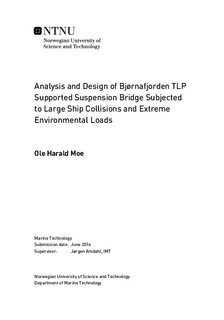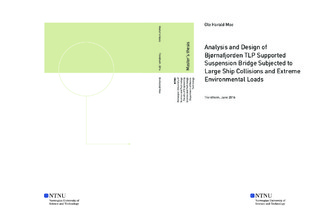| dc.description.abstract | The objective of this thesis is to study the global response of a tether anchored floating
suspension bridge over Bjørnafjorden when it is subjected to ship impacts and extreme
environmental loads. Bjørnafjorden south of Bergen is one of the fjords, where the ferry
crossing is proposed to be replaced by a bridge. The proposed crossing has a length
of over 4 000 metres and depths of over 450 metres. Due to the length and depth of
this fjord it is not possible to use a conventional bridge. Instead the proposed design
is to build a three span suspension bridge supported by two TLP floaters. Each of the
main spans has a length of 1 380 metres, and the sailing height is 45 metres. One of
the features of this design is a circular tube at the sea surface. This is connected to the
floater through tethers and is thought to give stability in the installation phase and act
as a barrier against ship impacts. The bridge has eigenperiods spanning from 100 to 4
seconds, making it behave dynamically for many types of loads.
The geometry of the barrier was established based on simplified methods in order to find
a combination minimising motions and strain energy. One of the key questions in this
thesis is how this barrier influences the response of the bridge due to ship impacts. In
order to establish this, several collision analyses were conducted with energies spanning
from 50 to 1 200 [MJ]. With the vessels both colliding against the barrier and directly
against the floater. In the analyses the ship was modelled as a nodal mass given an initial
velocity. It was connected to the bridge through springs. One of these where one was
given the force deformation characteristic of the vessel, while the other spring was used to
ensure that the system did not have any tensile stiffness. One of the key results from these
analyses was that the barrier increased the global motions, making it disadvantageous
for the global response.
Another key question in this thesis was to investigate the response of the bridge when
subjected to extreme environmental loads. The load components used were the 100 year
wind speed, and the second order drift force in the 100 year sea state. A stochastic
wind model was used to account for the time and spatial variability of the wind speeds.
Since both the wind and wave loads are of a stochastic nature, 30 one hour simulations
were conducted. This made it possible to use extreme value statistics to find the 100
year response to environmental loads. The 90 % percentile was used to account for short
term variability. These analyses showed that environmental loading yields a larger global
response than ship collisions, making it governing for design against global response. | |

